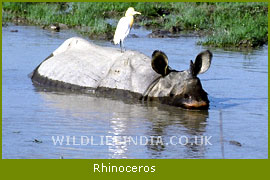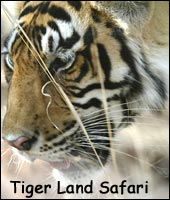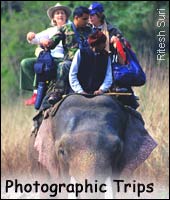HOME : Species of India - The Rhinoceros
THE RHINOCEROS
Out of all prehistoric looking creatures Rhinoceros is most unique in its shape and size. In the ancient times Rhino’s were found all over from Europe to the Middle East to Africa and to Asia. But now they are found only in Africa where two species exists and in Asia where three species are known to exist.In ancient times Rhino’s were found all over India and the Mughul historians have documented hunting Rhino’s near Delhi. At present only one species of Rhinoceros is found in India and that also is confined to the Assam and adjoining areas.
Due to many superstitious beliefs about the supposedly magical powers of Rhino’s horn it has been heavily poached and nearly faced extinction. But due to dedicated efforts by various governments it has now managed a come back and has been reintroduced in the terrain region of the Himalayas under constant supervision.
The Great Indian One Horned Rhinoceros (Rhinoceros unicornis)

It is the second largest of all Rhinoceros in size and comes after the White Rhino’s found in Africa. The average height of One Horned Rhinoceros is over 6ft at the shoulder. Its horn is not bigger than the ones found in African variety. The horn is mainly formed by a thick matt of fiber growing from the skin and is attached to the bone on the skull. It is in no way part of the skull or the bone to which it is attached.
The rhinoceros has a skin which looks like armor and has many folds around the shoulders and the front legs. The skin behind the shoulder especially the flanks and hindquarters has round tubercles giving it a distinct look.
In India it is found flood plains of West Bengal, the Dooars and the Assam. The ideal habitat of One Horned India Rhinoceros is swamps and the grasslands of the Dooars and Assam but they are also found in the low hills and jungles of West Bengal. With persistent efforts of the various authorities One Horned Rhinoceros has now been sighted in areas where it was wiped out because of hunting.
One Horned Rhinoceros is mainly a solitary animal but occasionally females can be seen together or a pair during the period of mating. The Rhinoceros main food is mainly grass but during the times of floods they enter the villages in search of food. Rhinoceros has a peculiar habit of dropping its excreta at same place and because of this habit they generally fall prey to the poachers.
The normal period of gestation in rhino’s is 16 months and usually one calf is born. In India majority of rhinoceros are found in the world famous Kaziranga National Park in Assam.
The Small One Horned Rhinoceros or the Javan Rhinoceros
This rhino was smaller in size to the Great One Horned Rhinoceros and once was thought to exist in Assam and neighboring Bengal. It is extinct now in India even though there are unconfirmed reports of its existence in the thick forests of Arunachal Pradesh neighboring Mynmar or Burma.



